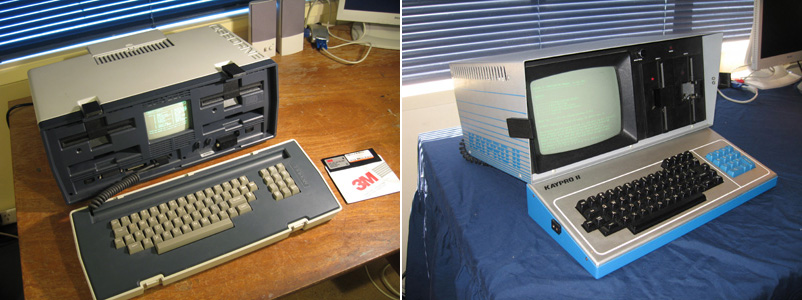| Tweet |
Making a Kaypro, Osborne or other CP/M computer boot disk (and getting other CP/M software) from disk images
Introduction
If you have found this page directly from an Internet search (as opposed to a link from my disk imaging introduction page) you have most likely missed some important information. Please click to READ THIS INTRODUCTORY PAGE FIRST. It explains some generic aspects of disk imaging and why, even if you DO have a good bootable disk, it may not work.

Figure 1. The Osborne 1 and the Kaypro II. Two classic CP/M machines
Hardware requirements
You'll need the following hardware:
- A computer with a 360k drive running Windows 98SE or earlier (although you CAN get away with one with a 1.2 MB drive. Click here for an alternative method if this is the case )
- Blank 5.25 inch double density (not high density) disks in good condition
A Windows 95 or MS-DOS machine would be fine. However, the software below DOES NOT work in Windows NT/2000/XP or above.
You'll need some way of getting disk images from the Internet into the type of machine described above. A direct Internet connection is the most straightforward. However if your disk imaging machine is NOT Internet capable, transfer of images from an Internet capable machine via network cable, serial/parallel cable, compatible disk drives, USB or CD-ROM are all possibilities.
Software and Images
Use the program ImageDisk to write disk images to floppy disks (and vice versa). This program can be found on Dave Dunfield's site here. The site also contains links to software for common CP/M machines including boot disks under the Systems / Install disk link. Another program you may need is 22DISK which can be found on this website. 22DISK allows you to swap files in and out of an MS-DOS environment and the CP/M disks.
One important thing. The software was written for MS-DOS not Windows. 22DISK in particular needs a Windowless environment. I found it best to boot straight to MS-DOS. To do this in Windows 98SE, I edited my MS-DOS.SYS configuration so that BootGUI=0. You have to make MS-DOS.SYS visible first before you can edit it. An alternative way may be to use a full-screen DOS window under Windows (load the MS-DOS command line program then press <alt><enter> to get a full screen). I haven't tried this but it could be ok. However, if you run into any problems with disk reading/writing consider booting the machine with an MS-DOS floppy hence ensuring no Windows artifacts are there at all.
Last words
The documentation is quite technical, but persist with it and you'll soon be churning out CP/M disks galore. Have fun!
Tez
23rd December, 2011
| Tweet |